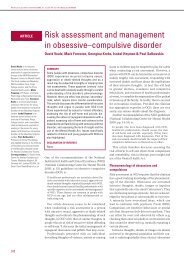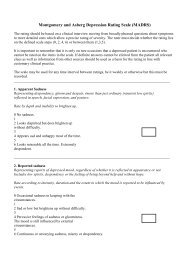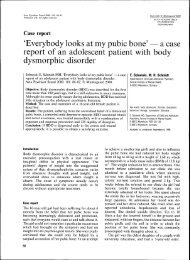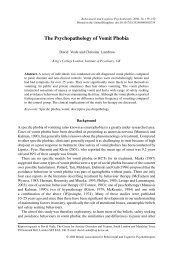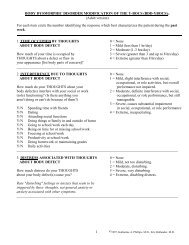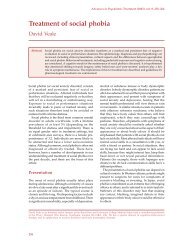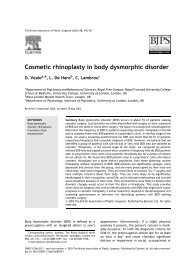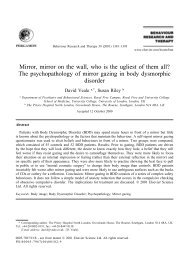BROWN ASSESSMENT OF BELIEFS SCALE (BABS) - Dr David Veale
BROWN ASSESSMENT OF BELIEFS SCALE (BABS) - Dr David Veale
BROWN ASSESSMENT OF BELIEFS SCALE (BABS) - Dr David Veale
You also want an ePaper? Increase the reach of your titles
YUMPU automatically turns print PDFs into web optimized ePapers that Google loves.
Brown Assessment of Beliefs Scale© (<strong>BABS</strong>) 5/1/01<strong>BROWN</strong> <strong>ASSESSMENT</strong> <strong>OF</strong> <strong>BELIEFS</strong> <strong>SCALE</strong>(<strong>BABS</strong>)DEVELOPED BYJANE L. EISEN, M.D. 1KATHARINE A. PHILLIPS, M.D. 1DOUGLAS BEER, M.D. 1KATHERINE D. ATALA, M.D. 2STEVEN A. RASMUSSEN, M.D. 1LEE BAER, Ph.D. 21DEPARTMENT <strong>OF</strong> PSYCHIATRY AND HUMAN BEHAVIOR<strong>BROWN</strong> UNIVERSITY SCHOOL <strong>OF</strong> MEDICINE2MASSACHUSETTS GENERAL HOSPITAL,HARVARD MEDICAL SCHOOLInvestigators interested in using this rating scale should contact <strong>Dr</strong>. Eisen at Butler Hospital, 345Blackstone Boulevard, Providence, Rhode Island 02906.1
Brown Assessment of Beliefs Scale© (<strong>BABS</strong>) 5/1/01INTRODUCTIONThe <strong>BABS</strong> © scale has been developed to rate the degree of conviction and insight patients haveconcerning their beliefs. These beliefs include delusions as well as the beliefs that may underlieobsessional thinking and phobias. Obsessions and delusions have traditionally been viewed asdichotomous phenomena, with obsessions being defined as intrusive ego-dystonic thoughts about whichthe patient maintains insight. On the other hand, delusions have been defined as false beliefs held firmlyby the patient without insight into the irrationality of the content of the belief. However, obsessions anddelusions might be better conceptualized as existing on a continuum of insight that ranges from goodinsight to poor insight (overvalued ideation) to no insight (delusional thinking). Such a continuum ofinsight may be present in a variety of psychiatric disorders--such as obsessive compulsive disorder, bodydysmorphic disorder, anorexia nervosa, and hypochondriasis--as well as in disorders traditionallyconsidered psychotic, such as schizophrenia and delusional disorder.The <strong>BABS</strong> © is based on this premise--that insight (i.e., degree of delusionality) exists on a continuum.It is also based on the premise that insight itself consists of a number of dimensions. Thus, the <strong>BABS</strong> ©rates a number of dimensions that underlie delusional and nondelusional beliefs. These dimensions are:conviction, perception of others' views of beliefs, explanation of differing views, fixity of ideas, attempt todisprove beliefs, insight, and ideas/delusions of reference.ADMINISTRATIONRatings:The <strong>BABS</strong> © consists of 7 items: the first 6 items are added to obtain the total <strong>BABS</strong> © score. Anadditional item (ideas of reference) is not included in the total score. Each item corresponds to one of thedimensions listed above. Each item is rated from 0 to 4 (from least to most severe). The instrument issemi-structured. The interviewer should assess the items in the listed order and should read the questionsprovided. However, additional questions may be asked to clarify patient responses. The italicizedstatements in parentheses that follow some of the questions are instructions to the interviewer that mayassist in obtaining valid ratings.In general, the items are rated based on the patient's report; however, the final answer selected foreach item depends on the interviewer's clinical judgment. If the patient volunteers information at anytime during the interview, that information should be considered. Ratings should be based primarily onreports and observations gained during the interview. Additional information supplied by other sourcesmay be used to determine ratings if it is felt to be useful and valid. If the rater judges that the informationbeing provided is grossly inaccurate, then the reliability of the patient or informant is in doubt and shouldbe noted accordingly on the interview.Rate each item according to the patient's experience during the past week up until and including thetime of the interview. Scores should reflect the average (mean) occurrence of each item for the entireweek. If insight has changed notably and rapidly during the past week (as may occur in psychotic mooddisorders, for example), the patient’s current state should be rated. The rater should note this departurefrom the standard <strong>BABS</strong> © convention.If the patient has more than one belief related to the same disorder (e.g., two different OCDobsessions), these beliefs should be rated as a composite. However, if the patient has beliefs connectedto two distinct disorders, e.g., beliefs of body distortion (body dysmorphic disorder) and obsessionsabout contamination (OCD), these beliefs should be rated separately.2
Brown Assessment of Beliefs Scale© (<strong>BABS</strong>) 5/1/01Identifying the Belief(s):This instrument can be used to assess beliefs in a variety of diagnoses. For example:DiagnosisObsessive Compulsive DisorderBody Dysmorphic DisorderAnorexia NervosaManiaDepression with Psychotic FeaturesSchizophrenia and Other Psychotic DisordersBeliefI will get contaminated from touching doorknobs.My nose is grotesquely deformed.I am fat.I am the president of the United States.My insides are rotting.A war is being waged within my body and themilitary has removed my heart.If the patient expresses his or her concern as a fear or worry, it is important that the interviewer determine and rate thenature of the underlying belief and associated consequence other than anxiety. For example, if the patient describes a fear oftouching doorknobs, the interviewer should determine what the underlying belief or consequence is--for example, that touchingdoorknobs will lead to illness. Question 1 would then read: "How convinced are you of your idea--that touching doorknobswill make you ill?" Some examples of beliefs that underlie fears or worries are listed below:Fear or worryI'm afraid of environmental contaminants.I worry I'll harm my grandchildren.I'm afraid the CIA will get me.I'm afraid of snakes.Underlying belief (preferred)If I step on a chemically treated lawn, I'll getcancer.I can't touch my grandchildren because if I do, I'll sexuallymolest them.If I don't barricade myself in my house, the CIAwill poison me.If I go into my back yard, I will be bitten by asnake and die.Even though the underlying belief is what should be assessed, the rater should use the most clinically appropriate term forthe belief being assessed--e.g., idea, belief, thought, worry, fear, or concern.The more specifically the belief is stated, the more likely the rating is to be valid. The interviewer should help the patientstate his or her belief as specifically as possible. Some examples of less specific and more specific beliefs (the latter beingpreferable) are listed below.Vague beliefTo prevent illness, I must take specialprecautions with my food.I have special powers.I'm ugly.I'm a bad person.Specific belief (preferred)To prevent illness, I must throw away any foodtouched by anyone else.I'm the most powerful person in the universeand the ruler of Jupiter and Mars.I have big red spots on my face, which makeme very ugly.I'm responsible for the California earthquake.3
Brown Assessment of Beliefs Scale© (<strong>BABS</strong>) 5/1/01If the patient uses an action (such as a compulsion in OCD, or dietary restriction in anorexia nervosa) toprevent a feared consequence from happening, then the action should be incorporated into the question aboutthe belief. For example, if the patient is afraid of getting AIDS, the interviewer should determine what measures thepatient takes to avoid or prevent possible exposure to AIDS and should incorporate these measures into the question.The interviewer should ask, "How convinced are you that you will get AIDS if you don't spend 3 hours a daywashing?" not "How convinced are you that you will get AIDS?" Some examples of beliefs that incorporate actionsare listed below on the right-hand side:Belief without actionI'll get fat.I'll harm others if I'm not careful.I'll fail my test.Belief incorporating an action (preferred)I'll get fat if I eat more than 20 Cheerios a day.I need to check the newspapers to make sure I'mnot a hit-and-run driver.If I don't put all of my papers in a certainposition, I'll fail my test.The rater should also assess what the patient thinks is actually true, not what might be true. For example, ifthe patient states that he/she is 100% convinced that he/she might get cancer from stepping on a lawn, theinterviewer should attempt to determine how convinced the patient is that he/she will get cancer from stepping on alawn and should rate the latter response.Other potential difficulties ascertaining the core belief include:Potential Mistakes1. The core belief is too narrow.For example, “My nose is crooked.”SolutionObtain a more fundamental belief, such as,“I look like the Elephant Man” because thisbelief encompasses all the patient’s beliefsabout his or her appearance and is moreclearly false (see below).2. The core belief is not clearly false.For example, “I have to stay in the hospital until I’m cured.” Obtain a belief that is clearly false, e.g., “Iwill be picked up by trolls in a spaceship.”3. The core belief shifts during the interview. Be sure to rate the same belief throughoutthe interview.To administer the scale, the rater and the patient need to agree on which beliefs/ideas/obsessions are beingevaluated. Prior use of other instruments (such as the Structured Clinical Interview for DSM-IV to identifydiagnoses, or the Y-BOCS symptom checklist to identify obsessions) can be helpful in identifying suchbeliefs/ideas/obsessions. In addition, a list of ideas/beliefs/obsessions to be rated can be generated by asking:Are there certain ideas or beliefs you have that are of significant concern to you?Which one would you rate as being of most concern?_____________________________________________________________________________ [Principal belief]4
Brown Assessment of Beliefs Scale© (<strong>BABS</strong>) 5/1/01Do you have other ideas (thoughts/beliefs) that you are preoccupied with?_____________________________________________________________________________________________Can you answer the following questions about the ideas/beliefs that you've been most concernedabout during the past week?As was noted previously, the interviewer should assist the patient in: 1) stating his or her beliefs as specificallyas possible, and 2) identifying any actions associated with the belief so they can be incorporated into questionsabout the belief.In general, the patient's specific belief can be incorporated into the question. For example, question 1 couldbe read as, "How convinced are you of your belief that you're practically bald? Are you certain your belief isaccurate?"; question 2 could be read as, "What do you think other people think of your belief that you're practicallybald? How certain are you that most people think your belief makes sense?"On repeated testing, the belief should be reviewed, and, if necessary, revised before doing the ratings.5
Brown Assessment of Beliefs Scale© (<strong>BABS</strong>) 5/1/01Instructions for specific items:Item 1: Conviction Description: The purpose of this item is to determine the patient's degreeof conviction about his/her belief(s).Item 2:Perception of others' viewsof beliefsDescription: The purpose of this item is to evaluate the patient’s abilityto accurately assess how others view his/her concerns.Scoring considerations: Patients may answer with what other peoplehave told them. However, the point of this item is to ascertain what thepatient thinks others REALLY think. Interviewer should clarify, ifnecessary, that the patient answers this question assuming that others aregiving their honest opinion. An additional probe to clarify this might be,“What do you think others would say if they had to be honest?” Anotherpitfall with this item is not rating what MOST people think. Thisquestion should not be answered according to what a few people thinkor what selected people think, e.g., friends and family.Item 3:Explanation of differingviewsDescription: The purpose of this item is to have the patient explaindifferences in his/her response to items 1 and 2, i.e., why other peoplehave a different view of the belief than the patient does.Scoring considerations: The interviewer should not ask this item ifresponses on item 1 and 2 are in agreement. If responses on item 1 and2 are in agreement, item 3 should be given the same response, e.g., ifitem 1 and 2 are scored as a 2, then item 3 should be scored as a 2.Item 4: Fixity of ideas Description: The purpose of this item is to evaluate how fixed orunshakable the patient's conviction about the belief is.Scoring considerations: The interviewer should determine whether thepatient can be convinced that his/her ideas are false during theinterview. An additional probe might be, "As we sit here now, could Iconvince you that your appearance is not grotesque?" If necessary,supply a nonconfrontational example. Patients may answer according towhether they would LIKE to be convinced that their belief is false.Rate on the basis of whether the patient could be convinced, not whethers/he wishes s/he could be convinced. Try to differentiate, if necessary,the patient’s compliance and desire to please the interviewer fromhis/her true ability to be convinced.Item 5: Attempt to disprove ideas Description: This item assesses how actively and frequently the patientattempts to disprove or reject his/her ideas as being untrue or wrong. Itdoes not simply rate the patient’s efforts to push the thoughts away.Item 6: Insight Description: The purpose of this item is to determine the patient's abilityto assign a psychiatric or psychological cause for the belief.6
Brown Assessment of Beliefs Scale© (<strong>BABS</strong>) 5/1/01Scoring considerations: Interviewer should determine what the patientactually believes, not what s/he has been told is true.Item rated but not included in the total <strong>BABS</strong> © score:ADDITIONAL ITEM:Item 7: Ideas/delusions ofreferenceDescription: This item assesses whether the patient has referentialthinking about the environment based on the content of the belief(s).Scoring considerations: This question pertains only to the belief(s)being assessed by the interviewer---not if the patient thinks s/he isnoticed for a reason unrelated to the beliefs being assessed.Examples:1. Do you think people take special notice of you or make fun of youbecause of your appearance?2. Do you think people take special notice of you because you seemlike someone who might harm their children?3. Do you think people take special notice of you because you're anangel? [PAUSE] What about receiving special messages from theenvironment because you're an angel?SCORINGAll items should be rated. The total score is the sum of items 1 through 6. Item 7 should be rated but not includedin the total score.7
Brown Assessment of Beliefs Scale© (<strong>BABS</strong>) 5/1/01Name______________________Date_______________________Diagnosis_______________________Treatment_______________________Belief (describe principal belief(s) during the past week):_______________________________________________________________________________________________________________________________________________________________________________For each item, circle the number identifying the response that best characterizes the patient over the past week.The patient's specific belief can be incorporated into the question--for example, "How convinced are you of thisbelief that touching doorknobs will make you ill?" Optional questions are indicated in parentheses; instructionsto the interviewer are italicized.1. ConvictionHow convinced are you of these ideas/beliefs? Areyou certain your ideas/beliefs are accurate? (What doyou base your certainty on?)0.- Completely convinced beliefs are false (0%certainty).1.- Beliefs are probably not true, or substantialdoubt exists.2.- Beliefs may or may not be true, or unable todecide whether beliefs are true or not.3.- Fairly convinced that beliefs are true but anelement of doubt exists.4.- Completely convinced about the reality ofheld beliefs (100% certainty).2. Perception of others' views of beliefsWhat do you think other people (would) think of yourbeliefs? [PAUSE] How certain are you that mostpeople think your beliefs make sense?(Interviewer should clarify, if necessary, that thepatient answers this question assuming thatothers are giving their honest opinion.)(Interviewer should make sure that the patientanswers according to what MOST people thinknot some people or selected people.)0.- Completely certain that most people thinkthese beliefs are unrealistic.1.- Fairly certain that most people think these beliefsare unrealistic.2.- Others may or may not think beliefs areunrealistic, or uncertain about others' viewsconcerning these beliefs.3.- Fairly certain that most people think thesebeliefs are realistic.4.- Completely certain that most people thinkthese beliefs are realistic.3. Explanation of differing viewsYou said that (fill in response to item 1), but that (fillin response to item 2). [PAUSE] How do you explainthe difference between what you think and whatothers think about the accuracy of your beliefs?(Who's more likely to be right?)(Interviewer should not ask this item if responseson item 1 and 2 are the same. In that case,give the same score as items 1 and 2.)0.- Completely certain that beliefs are unrealistic orabsurd (e.g., "my mind is playing tricks on me.")1.- Fairly certain that beliefs are unrealistic or absurd.2.- Uncertain about why others don’t agree--beliefsmay or may not be true.3.- Fairly certain that beliefs are true; view of othersis less accurate.4.- Completely certain that beliefs are true; view ofothers is not accurate.8
Brown Assessment of Beliefs Scale© (<strong>BABS</strong>) 5/1/014. Fixity of ideasIf I were to question (or challenge) the accuracy of yourbeliefs, what would your reaction be? [PAUSE] Could Iconvince you that you are wrong? [PAUSE] Would youconsider the possibility?(If necessary, supply a nonconfrontational example.)(Rate on the basis of whether the patient could beconvinced, not whether s/he wishes s/he could beconvinced.)0.- Eager to consider the possibility that beliefsmay be false; demonstrates no reluctance toentertain this possibility.1.- Easily willing to consider the possibilitythat beliefs may be false; reluctance to do sois minimal.2.- Somewhat willing to consider thepossibility that beliefs may be false, butmoderate resistance is present.3.- Clearly reluctant to consider the possibilitythat beliefs may be false; reluctance issignificant.4.- Absolutely refuses to consider the possibilitythat beliefs may be false--i.e., beliefs arefixed.5. Attempt to disprove ideasOver the past week, how often have you tried to convinceyourself that your beliefs are wrong?(Interviewer should rate attempts patient makes to talkhimself/herself out of the belief, not attempts to push thethoughts/ideas out of his/her mind or think about somethingelse.)0.- Always involved in trying to disprove beliefs,or not necessary to disprove because beliefsare not true.1.- Usually tries to disprove beliefs.2.- Sometimes tries to disprove beliefs.3.- Occasionally attempts to disprove beliefs.4.- Makes no attempt to disprove beliefs.6. InsightWhat do you think has caused you to have these beliefs?[PAUSE] Do they have a psychiatric (or psychological)cause, or are they actually true?(Interviewer should determine what the patientactually believes, not what s/he has been told or hopes istrue. Psychological etiology should be consideredequivalent to psychiatric illness.)0.- Beliefs definitely have apsychiatric/psychological cause.1.- Beliefs probably have apsychiatric/psychological cause.2.- Beliefs possibly have apsychiatric/psychological cause.3.- Beliefs probably do not have apsychiatric/psychological cause.4.- Beliefs definitely do not have apsychiatric/psychological cause.(Recognition that the thoughts are excessive--i.e., taking uptoo much time--or causing problems for the patient shouldnot be considered equivalent topsychiatric/psychological etiology. Instead, rate patient'sawareness that the source/cause of the beliefs ispsychiatric/psychological.)TOTAL <strong>BABS</strong> © SCORE __ = SUM <strong>OF</strong> QUESTIONS 1 THROUGH 69
Brown Assessment of Beliefs Scale© (<strong>BABS</strong>) 5/1/01ADDITIONAL ITEM:7. Ideas/delusions of referenceDoes it ever seem that people are talking about you ortaking special notice of you because of (fill in belief)?OPTIONAL:What about receiving special messages from yourenvironment because of (fill in belief)? (How certain areyou of this?)(This question pertains only to the belief(s)being assessed by the <strong>BABS</strong> interviewer–not if patientthinks s/he is noticed for a reason unrelated to thebeliefs being assessed.Interviewer should NOT base answer on observableactions or compulsions; instead, rate core belief.)0.- No, others definitely do not take special noticeof me.1.- Others probably do not take special notice ofme.2.- Others may or may not take special notice ofme.3.- Others probably do take special notice of me.4.- Others definitely do take special notice of me.(Do not include in total score)10
Brown Assessment of Beliefs Scale© (<strong>BABS</strong>) 5/1/01<strong>BABS</strong> © KEYSHEET (R)Patient Initials:__________Date of Interview:____/_____/_____Rater:_________________Diagnosis:______________________Treatment:__________________________Principal Belief:_______________________________________________1. CONVICTION _________2. PERCEPTION <strong>OF</strong> OTHERS' VIEWS _________3. EXPLANATION <strong>OF</strong> DIFFERING VIEWS _________4. FIXITY <strong>OF</strong> IDEAS _________5. ATTEMPT TO DISPROVE <strong>BELIEFS</strong> _________6. INSIGHT _________TOTAL <strong>BABS</strong> © SCORE (total of items 1-6)_________ADDITIONAL ITEM:7. IDEAS/DELUSIONS <strong>OF</strong> REFERENCE _________RATE YOUR OVERALL IMPRESSION <strong>OF</strong> THE PATIENT'S DEGREE <strong>OF</strong> INSIGHT:0. Excellent Insight; fully rational1. Good Insight2. Fair Insight3. Poor Insight4. Lacks Insight; delusional11



